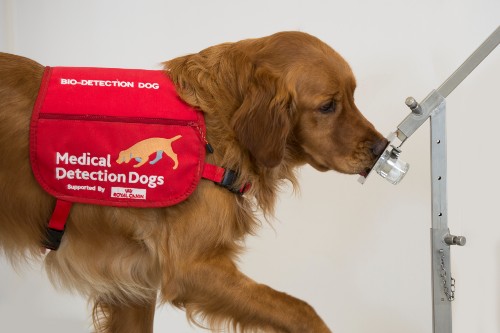A University of Bristol study finds trained detection dogs can identify parkinson’s disease with up to 98% accuracy by smelling skin swabs, offering promise for early, non-invasive diagnosis
A groundbreaking study by the University of Bristol has shown that trained detection dogs can accurately identify Parkinson’s disease using skin swabs. With a specificity of up to 98%, the research highlights the potential of scent-based diagnosis as a fast and non-invasive screening tool for the earlier detection of the condition.
The findings of this groundbreaking study, which are detailed in The Journal of Parkinson’s Disease, a reputable scientific publication, have significant implications for the field of Parkinson’s disease research and diagnosis.
Sniffing out Parkinson’s disease
Parkinson’s disease has no definitive diagnostic test; therefore, identifying potential biomarkers can support early diagnosis and intervention. The research team utilised medical detection dogs, which possess an extraordinary sense of smell and have been trained to detect a range of diseases.
Two dogs, named Bumper and Peanut, were trained by the charity Medical Detection Dogs to distinguish between oily sebum swabs from people with and without Parkinson’s disease. They were trained over 38 weeks using 205 odour samples from individuals who tested positive for the disease and control samples from individuals who did not have the disease. The samples were presented to the medical detection dogs on a stand system, and the dogs were rewarded for correctly indicating a positive sample and for correctly ignoring a negative sample.
Highly sensitive results
The researchers conducted a double-blind trial and found that dog one achieved 70% sensitivity and 90% specificity, while dog two achieved 80% sensitivity and 98.3% specificity. This means both dogs could correctly identify the majority of Parkinson’s disease cases and avoid false positives in most control samples. The agreement between the dogs’ responses was significantly higher than chance for Parkinson’s disease samples, reinforcing the reliability of their detection. These findings suggest that dogs can consistently detect a unique scent associated with Parkinson’s disease and may support future efforts in early, non-invasive screening.
Nicola Rooney, Associate Professor at Bristol Veterinary School at the University of Bristol and lead author, says: “Identifying diagnostic biomarkers of PD, particularly those that may predict development or help diagnose disease earlier, is the subject of much ongoing research. The dogs in this study demonstrated high sensitivity and specificity, indicating the presence of an olfactory signature distinct to patients with the disease. Sensitivity levels of 70% and 80% are well above chance, and I believe that dogs could help us to develop a quick, non-invasive, and cost-effective method to identify patients with Parkinson’s disease.“
Perdita Barran, Professor of Mass Spectrometry at The University of Manchester, said: “It’s wonderful to be part of this research inspired by Joy Milne and our Nose2Diagnose programme. This study adds to the growing body of evidence showing that simple, non-invasive skin swabs can be used to diagnose Parkinson’s disease, offering a faster and more accessible method for early detection.”
Claire Guest, Medical Detection Dogs CEO and Chief Scientific Officer, says: “We are incredibly proud to say that once again, dogs can very accurately detect disease.
“There is currently no early test for the disease, and symptoms may start up to 20 years before they become visible and persistent, leading to a confirmed diagnosis.
“Timely diagnosis is key as subsequent treatment could slow down the progression of the disease and reduce the intensity of symptoms.”








